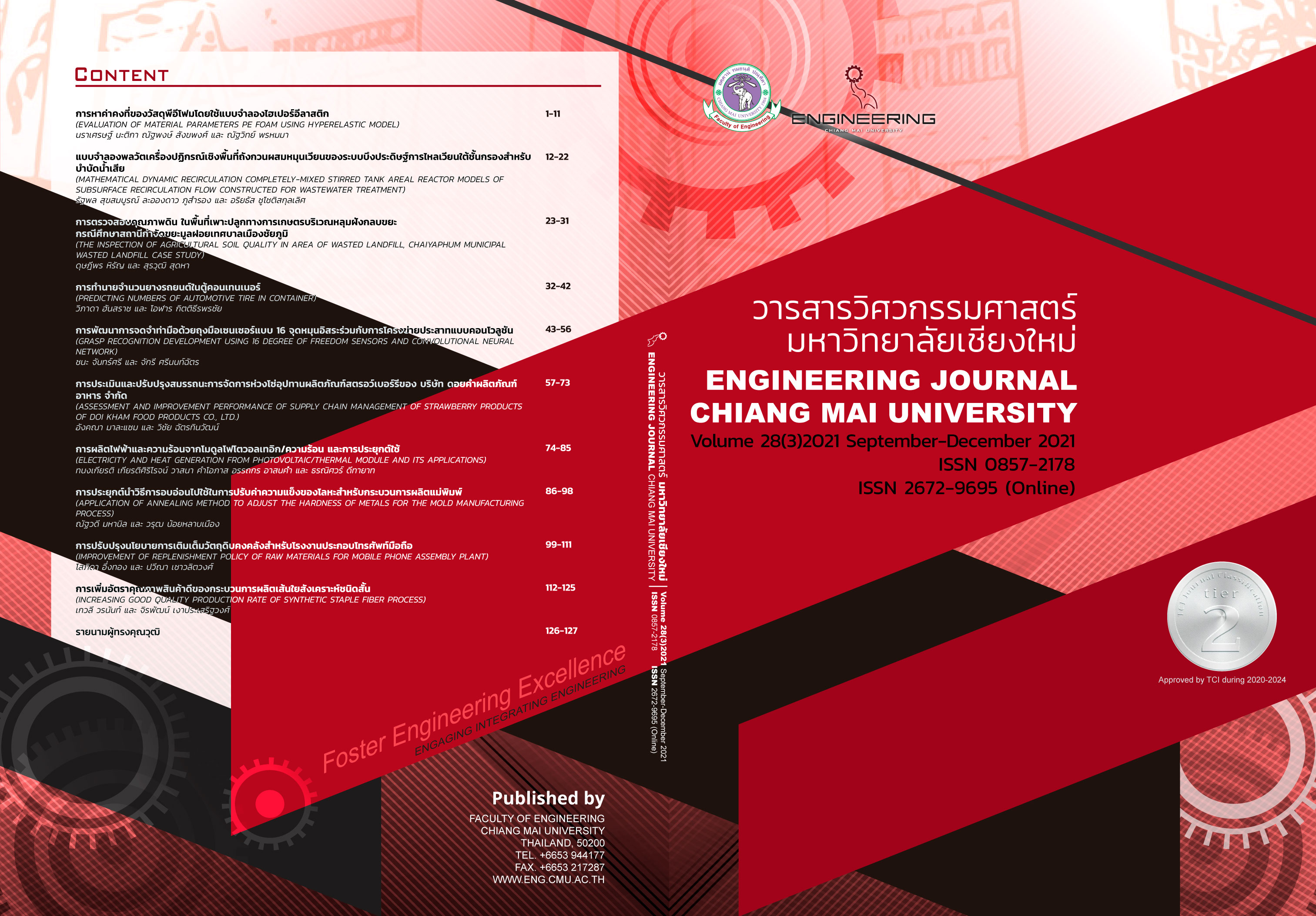Mathematical Dynamic Recirculation Completely-Mixed Stirred Tank Areal Reactor Models Of Subsurface Recirculation Flow Constructed For Wastewater Treatment
Keywords:
Mathematical modeling, Recirculation completely-mixed stirred tank areal Reactor, Surface recirculation flow constructed Wetland, Waste water treatmentAbstract
The objective of this study was to develop the model of recirculation completely-mixed stirred tank areal reactor (RCSTAR) of recirculation surface flow constructed wetland (RSFCW) using granular activated carbon (GAC) as a media contained in 29 pots of reed. The ratio of width to: length was <1:4, used travel area was 0.50 m2, and the initial height of bed 20 cm. The result of the study found that the recirculation ratio: QR/Qin (R) was 3. The hydraulic recirculation time (HReT) was 2 hrs for treat washing waste water. As a result, the efficiency of COD and BOD removal was 90.19% and 87.50%, respectively which cause the second-order-reaction with areal rate coefficient (kA2nd) equals 0.158 and 0.223 m/day, respectively.
References
รัฐพล สุขสมบูรณ์ และ ชัยยันต์ จันทร์ศิริ, “ศักยภาพเครื่องปฏิกรณ์กวนชีวภาพแบบฟลูอิไดซ์เบดตัวกลางถ่านกัมมันต์ชนิดเม็ด,” วารสารเกษตรพระวรุณ มหาวิทยาลัยราชภัฏมหาสารคาม, ปีที่ 15, เล่ม 1, หน้า 238-247, 2561.
รัฐพล สุขสมบูรณ์, ชัยยันต์ จันทร์ศิริ, วุฒิกร สายแก้ว, และ ศิวดล กัญญาคำ, “แบบจำลองทางคณิตศาสตร์ของเครื่องปฏิกรณ์กวนชีวภาพแบบฟลูอิไดซ์เบดตัวกลาง ถ่านกัมมันต์ชนิดเม็ดในการบำบัดน้ำเสียชุมชนเพื่อใช้ทางการเกษตร,” วารสารเกษตรพระวรุณ มหาวิทยาลัยราชภัฏมหาสารคาม, ปีที่ 16, ฉบับที่ 2, หน้า 259–269, 2562.
R. Suksomboon, C. Junsiri, S. Tangjitjaroenkit, M. Moselhy, and P. Padungthon, “Mathematical models of a fluidized bed bioreactor using granular activated carbon (FBBR-GAC) for wastewater treatment,” Engineering and Applied Science Research, vol. 46, no. 3, pp. 183-191, 2019.
V. V. Chandanshive, N. R. Rane, A. S. Tamboli, A. R. Gholave, R. v Khandare, and S. P. Govindwar, “Co-plantation of aquatic macrophytes Typha angustifolia and Paspalum scrobiculatum for effective treatment of textile industry effluent,” Journal of Hazardous Materials, vol. 338, pp. 47–56, 2017.
F. Masi et al., “Lessons learnt from a pilot study on residual dye removal by an aerated treatment wetland,” Science of the Total Environment, vol. 648, pp. 144–152, 2019.
รัฐพล สุขสมบูรณ์, ชัยยันต์ จันทร์ศิริ, ศิวดล กัญญาคำ, และ สุธาวัลย์ ตั้งจิตเจริญกิจ, “แบบจำลองทางคณิตศาสตร์ของระบบบึงประดิษฐ์การไหลเวียนใต้ชั้นกรองในการบำบัดน้ำเสียชุมชนสำหรับที่พักอาศัย,” วารสารวิจัยราชภัฏเชียงใหม่, ปีที่ 22, ฉบับที่ 2, หน้า 37-48, 2564.
A. Gross, O. Shmueli, Z. Ronen, and E. Raveh, “Recycled vertical flow constructed wetland (RVFCW)—a novel method of recycling greywater for irrigation in small communities and households,” Chemosphere, vol. 66, no. 5, pp. 916–923, 2007.
รัฐพล สุขสมบูรณ์, “การออกแบบระบบสวนน้ำเพื่อฟื้นฟูคูคลองในเขตเมืองด้วยแบบจำลองคณิตศาสตร์,” วิทยานิพนธ์ วศ.บ (สิ่งแวดล้อม), มหาวิทยาลัยขอนแก่น, ขอนแก่น, 2550.
P. Knowles, G.Dotro, J. Nivala, and J. Garcia, “Clogging in subsurface-flow treatment wetlands,” Ecological Engineering, Amsterdam, vol.37, pp. 99-112, 2011.
P. Yu and Y. Luo, “Novel water treatment process—combined cationic ion-exchange bed and degasifier in a three-phase fluidized bed,” Desalination, vol. 151, no. 2, pp. 145–152, 2003.
N. Fernández, S. Montalvo, L. Guerrero, E. Sánchez, I. Cortés, and L. Travieso, “Anaerobic fluidized bed reactor application to tropical fruit wine effluent,” Water science and technology, vol. 56, no. 2, pp. 33–38, 2007.
R. Sowmeyan and G. Swaminathan, “Evaluation of inverse anaerobic fluidized bed reactor for treating high strength organic wastewater,” Bioresource technology, vol. 99, no. 9, pp. 3877–3880, 2008.
S. R. Qasim, E. M. Motley, and G. Zhu, Water works engineering: planning, design, and operation. New Jersey: Prentice Hall, 2000.
J. Nivala et al., “Comparative analysis of constructed wetlands: The design and construction of the ecotechnology research facility in Langenreichenbach, Germany,” Ecological Engineering, vol. 61, pp. 527–543, 2013.
W. Xing et al., “Enhancement of the performance of anaerobic fluidized bed bioreactors (AFBBRs) by a new starch based flocculant,” Separation and purification technology, vol. 72, no. 2, pp. 140–146, 2010.
A. Zafarzadeh, B. Bina, M. Nikaeen, A. H. Movahedian, and N. M. Hajian, “Performance of Moving Bed Biofilm Reactors for Biological Nitrogen Compounds Removal from Wastewater by Partial Nitrification-Denitrification Process,” Iranian Journal of Environmental Health Science & Engineering, vol.7, no. 4, pp. 353-364, 2010.
R. H. Kadlec and S. Wallace, Treatment wetlands. 2nd ed. Florida: CRC press, 2008.
K. Haribabu and V. Sivasubramanian, “Treatment of wastewater in fluidized bed bioreactor using low density biosupport,” Energy Procedia, vol. 50, pp. 214–221, 2014.
K. Haribabu and V. Sivasubramanian, “Biodegradation of organic content in wastewater in fluidized bed bioreactor using low-density biosupport,” Desalination and Water Treatment, vol. 57, no. 10, pp. 4322–4327, 2016.
กรมควบคุมมลพิษ, “คู่มือการจัดการน้ำเสียสำหรับบ้านเรือน – Pollution Control Department,” สิงหาคม, 2555. [Online]. Available: https://www.pcd.go.th/publication/4551/.
APHA, AWWA, and WEF, Standard Methods for the Examination of Water and Wastewater, 23rd ed. Washington: American Public Health Association, 2017.
Downloads
Published
Issue
Section
License
ลิขสิทธิ์ของบทความที่ตีพิมพ์ในวารสารฉบับนี้จะยังเป็นของผู้แต่งและยินยอมให้สิทธิ์เผยแพร่กับทางวารสาร
การเผยแพร่ในระบบวารสารแบบเปิดนี้ บทความจะสามารถนำไปใช้ได้ฟรีในการศึกษา และในทางที่ไม่เกี่ยวกับการค้า




